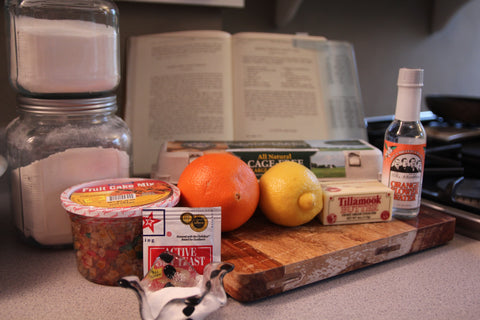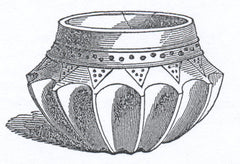Our Blog : Learn More About the Twelve Days of Christmas
Hanging Gifts ON the Tree
Did you know that Christmas presents used to be hung on the tree, instead of placed under the tree? In the 1800s, Victorian ladies' magazines promoted hanging presents on a Christmas fir tree and illustrated examples of tree trimming activities such as interwoven ribbons to hold gifts like dolls, toy horses, and little wagons on the tree itself.
Some of the earliest ornaments were fruits such as apples, pears and nuts - treats to savor when the tree was taken down at the end of the Twelve Days of Christmas. As time when on, homemade sweets, such as sturdy gingerbread cookies, also awaited on the tree's branches. While these goodies could be hung on the tree's boughs by strings or cords or carefully balanced in the crook of a branch, they were more secure when tucked into a delicately woven miniature basket or folded paper cone. These presents were more of a surprise and delight when the container's contents were revealed only upon being taken off the tree. Before long, these homemade containers were used to hold small handcrafted gifts or toys for the children.
 Popular periodicals published instructions to make containers to hang on the tree, including candy boxes in various shapes and cardboard cornucopias covered in paper (see image at left). Advertisements showed fancy ready-made boxes covered with paper cutouts of Santa or angels, and embellished with velvet, feathers, or fringe. These ornate containers were both elaborate ornamentation for the tree and holders for Christmas presents like nuts, candies, small gifts and toys like marbles or jacks.
Popular periodicals published instructions to make containers to hang on the tree, including candy boxes in various shapes and cardboard cornucopias covered in paper (see image at left). Advertisements showed fancy ready-made boxes covered with paper cutouts of Santa or angels, and embellished with velvet, feathers, or fringe. These ornate containers were both elaborate ornamentation for the tree and holders for Christmas presents like nuts, candies, small gifts and toys like marbles or jacks.
Even children's periodicals featured stories of Santa himself hanging little packages and treats one by one on the family's tree, instead of inside their stockings, or under the tree.

Dresdens
Another popular way to hang presents on the tree were Dresdens - three-dimensional hollow containers made of damp cardboard sheets that were molded and embossed into all sorts of fanciful shapes, such as suns, moons, sleighs, and every animal imaginable. They were then painted and lacquered to look as if they were made of gilded metal. While they were beautiful containers in which to hang candy on the Christmas tree, they were not very durable.
Christmas Cornucopia

Dresdens

Barnum's Animal Crackers Boxes
One of the best examples of a box designed to hold treats on a Christmas tree - and still widely available today - is the Barnum's Animal Cracker's box, a favorite childhood memory for over one hundred years. In 1902, the National Biscuit Company (Nabisco) launched the circus car box as a Christmas promotion, with the string attached so that the box of Barnum's Animal Crackers could be hung directly on the Christmas tree. The string has remained a part of the package ever since then.
Wassailing the Apple Trees
Wassailing was an old country tradition that took place on Twelfth Night or "Old Christmas Eve," especially in areas where cider apples were grown. Right before dark that wassail (spiced ale or hard cider topped with roasted apples) would be prepared and ladled into the special wassail bowl (similar to a punch bowl with handles). The village would gather at the orchard after dark with the wassail on hand and proceed to bang pots, shoot off guns, and make a racket to frighten away any evil spirits that could still be lurking about on this last night of Christmas. This commotion would also help to begin to "wake up" the trees from their winter hibernation. The trees were blessed with thanks and urged with rhyming chants to produce an even better crop in the new year. The oldest, most venerable tree's health would be "toasted" with a piece of wassail-soaked bread or cake placed in its branches.
If wassail was left over after regaling the trees, then the ceremonies would conclude with the villagers quenching their own thirst before returning home. In some areas, the young people would go from house to house in the village, singing wassail songs and receiving small gifts or treats in return.
Wassail is an old Middle English contraction of waes hael, meaning "be health" or "be whole," that was derived from the old Norse ves heill "to be healthy." The reply to waes hael was drinc hael, or "drink and be healthy." The modern expression "hale and hearty" shares the same roots.
Recipes:
A Swinging Wassail
- 1 quart ale
- 1 teaspoon cinnamon
- 5 or 6 pieces cracked ginger or 1 teaspoon powdered ginger
- 2 cups sherry wine
- Juice and thinly pared rind of 1 lemon
- Sugar, to taste
- 2 slices toasted bread (if desired)
- 6 or 8 baked crab apples or 2 or 3 baked large apples
Heat ale in saucepan until just about to boil. Stir in spices, sherry, lemon juice, slivered rind and sugar. Stir until sugar dissolves then cover and simmer over low heat for 20 to 30 minutes. Do not boil at any time. Remove from heat and either pour into punch bowl or individual cups and add toast (if desired) and apples.
The Significance of the Number Twelve Throughout the Ages
On 12-12-12, I thought a post about the significance of the number 12 would be nothing but appropriate, so here you go:
The Role of the Moon
A lunar month, from new moon to new moon, averages 29 ½ days. Twelve lunar months, of a lunar, is about 354 days – short of the 365 ¼ days in the solar year. As a result, additional days – roughly twelve – are needed to keep lunar timekeeping in step with the seasons. For our forebears, these twelve “extra” days were a mystical season out of ordinary time, suspended in the twelve-day gap between cosmic cycles of the moon and sun. These “extra” days are one in the same as The Twelve Days of Christmas.Ancient Egyptians
The ancient Egyptians were one of the first people to develop a twelve-month calendar that was based only on the sun instead of the moon. They also divided the day and the night in to twelve hours each.Mesopotamians and Ancient Persians
The Mesopotamians held an annual fire festival for twelve days surrounding the winter solstice (the twelve shortest days of the year) to cheer on their sun god as he battled to conquer the monsters of darkness and chaos. The ancient Persians held a similar solstice celebration with bonfires burning all night to help their god of light and day defeat the evil god of darkness and night.Ancient Slavic Rituals
In the lands of the ancient Slavic tribes, both sun gods and sun goddesses were revered during their winter solstice festivals, which lasted ten to twelve days and were a time when Slavs honored their departed ancestors with fires to keep them warm and feasts to keep them fed, hoping to elicit their assistance in defeating the dark forces that were overpowering the old sun.My first Twelfth Night Cake - French Edition

This cake takes allllllll day to make - but it is not difficult. There are hours and hours of down-time to do other things. From start to finish I think this cake took me about nine hours to make - so start first thing in the morning!
Ingredients for the cake:

- 1 envelope dry yeast
- 1 tablespoon lukewarm water
- 3 whole eggs + 1 egg yolk
- 1 teaspoon salt
- 2/3 cup sugar
- Zest of 1 lemon
- Zest of 1/2 orange
- 1 tablespoon orange-flower water (a non-alcoholic mixer - available at Bev Mo, or other liquor stores)
- 2 cups flour
- 1/2 cup (1 stick) softened unsalted butter, cut into small pieces
Instructions for the cake:
1. Dissolve packet of yeast into lukewarm water in a small bowl.





Ingredients for the glaze/topping:

- Candied cherries and fruit peels (I used a fruit-cake mix of candied fruits)
- 1/3 cup powdered sugar
- 1 1/2 tablespoons cornstarch
- 1/2 teaspoon vanilla (or almond) extract
- 1 teaspoon rum (or brandy) (optional)
- 1/2 to 1 1/4 tablespoons hot water, as needed
Instructions for the glaze:
1. Combine sugar, cornstarch, extract and liquor (if desired).
2. Gradually add hot water, one tablespoon at a time, until a smooth, thick paste is achieved.
3. Spread glaze on cooled cake, spread with knife, sprinkle with candied sugar pieces.
4. Let glaze dry, or, if you are impatient like me, just dig in and enjoy!

Both recipes adapted from Visions of Sugarplums by Mimi Sheraton, 1981.
Bowls and Boxes of Holiday Presents
The Urn of Fate

Instead of a bowl full of jelly, how about a bowl full of presents? Ancient Romans exchanged gifts for luck in the New Year, and many Italian families still take turns drawing small gifts by chance from a large bowl called the "Urn of Fate" at their Christmas gatherings.
For more information on Italian Christmas traditions, check out this page, and this page.
Boxes of Hope and Goodwill

In the Middle Ages, earthenware boxes with a slit on top for coins became known as Christmas boxes. On the First Day of Christmas, the nobility distributed these boxes to their servants who later broke them open to receive the small sums of money inside. Other boxes were used as a Yuletide tip jar for guild tradesman (the material used for these boxes was called pygg - the predecessor of piggy banks).
During Advent, donations were collected in churches and monasteries in alms boxes also referred to as Christmas boxes. On the day after Christmas, these boxes were opened and the contents were distributed among the poor. Still other boxes were kept aboard sailing ships for donations to the priest who would offer mass - Christ-mass - prayers upon the safe return of the sailors.
Not surprisingly, the First Day of Christmas (December 26th) is still known as Boxing Day in many parts of the world that once formed the British empire.
Recent Posts
Christmas Food Traditions from Around the World
Categories
- 60 Days of Gift Ideas
- Alternative Gift Giving
- announcements
- Boxing Day
- carol
- Chipmunk Christmas
- Christmas Cake
- Christmas Carols
- Christmas Party Ideas
- Christmas Recipes
- Creatures of the Twelve Nights
- Epihpany
- Family gifts
- Fire Rituals
- food gifts
- Gift Giving Ideas
- gifts for anyone
- gifts for anyone. DIY gifts
- gifts for babies
- gifts for her
- gifts for kids
- gifts for men
- gifts for teens
- gifts for under $10
- gifts for under $20
- gifts for under $30
- gifts for women
- Hanging Gifts ON the Tree
- Hippo Christmas
- History of Christmas Carols
- Holiday Decorating Ideas
- Last Minute Gifts
- Learn More About the Twelve Days of Christmas
- muppets
- New Christmas Traditions
- outdoorsy
- shipping
- Significance of Number Twelve
- Significance of Winter Greenery
- song
- sports gifts
- Stocking Stuffers
- techie/gadget gifts
- The Origin of Christmas Gift Boxes
- Twelfth Day of Christmas
- Twelfth Night
- Twelfth Night Cake
- Twelfth Night Party
- Twelve Days gifts
- Twelve Days Recipes
- Twelve Days-Themed Gifts
- video
- Wassail
- Where to shop for Twelve Days Gifts
- wine gifts
- Winter Solstice Rituals
- Woman's Christmas
